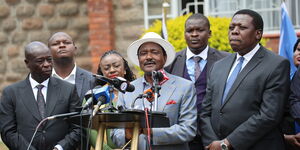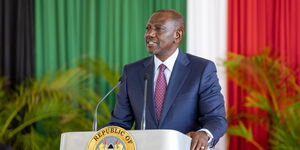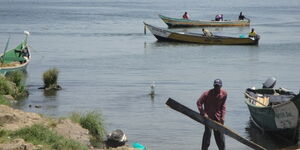The International Court of Justice (ICJ) has ruled that Kenya will give up part of the disputed maritime territory to Somalia.
The order was made as the Hague-based court made the judgment on the protracted delimitation case on Tuesday, October 12. The judges found that there was no evidence Somalia submitted to Kenya's use of latitude and longitude to determine maritime borders.
Further, the ICJ partially agreed that Somalia had a right to the oil-rich region of the disputed area of the Indian Ocean - but sought to strike a balance by allowing them only an extra 200 nautical miles (about 370 kilometres) of the area currently controlled by Kenya.
The court, in its verdict, adjudged and declared that Kenya, by its conduct in the disputed area, did not violate its international obligations and therefore not responsible under international law to make full reparation to Somalia.
While issuing the ruling, Judge Joan E. Donoghue, noted that the court regretted Kenya's decision not to proceed in the case. In the ruling delivered by the International Court of Justice (ICJ), the judges ruled that there is no agreed maritime boundary agreement between Kenya and Somalia.
The court was thus tasked with identifying the maritime boundary.
"Kenya has not consistently maintained its claim that the maritime border with Somalia is defined by the line of latitude between the two side," the judge stated.
Kenya's proposal to shift delimitation to a strictly eastern direction, she argued, does not constitute an "equitable solution." The court further rejected Kenya's claim that its fisheries and other economic/patrol activities would be unreasonably impacted by an "equidistance line."
In her ruling, the Justice highlighted that both states are members of the United Nations Convention on the Law of the Sea (UNCLOS) and the Court must take this treaty into account, notes geographic "base points" for resolving delimitation matters.
She noted that geographic "base points" must be from the mainland not from spits of land visible only at low tide. The Court's goal remained offering "an equitable solution."
The justice added that Kenya's maritime interests with Tanzania on its southern border are drawn in a more conventional manner than is being sought for Somalia in the north. Thus the border between Tanzania and Kenya does not affect the border between Kenya and Somalia.
"Maritime delimitation must be solved by the countries. If this fails, a third party is allowed to intervene," the judge noted adding that the main question was whether there exists an agreement between the two states.
The court also ruled that it was not convinced that the provisional equidistance line would entail Kenya being denied access to its fisherfolk and natural resources. "17 out of 19 fish landing sites would be unaffected." it ruled.
ICJ decided that the starting point of the single maritime boundary delimiting the respective maritime areas between the Federal Republic of Somalia and the Republic of Kenya is the intersection of the straight line extending from the final permanent boundary beacon (PB 29) at right angles to the general direction of the coast with the low-water line, at the point with coordinates 1° 39' 44.0" S and 41° 33' 34.4" E (WGS 84);
From the starting point, the maritime boundary in the territorial sea follows the median line described at paragraph 117 above until it reaches the 12-nautical-mile limit at the point with coordinates 1° 47' 39.1" S and 41° 43' 46.8" E (WGS 84) (Point A).
From the end of the boundary in the territorial sea (Point A), the single maritime boundary delimiting the exclusive economic zone and the continental shelf up to 200 nautical miles between the Federal Republic of Somalia and the Republic of Kenya follows the geodetic line starting with azimuth 114° until it reaches the 200-nautical-mile limit measured from the baselines from which the breadth of the territorial sea of the Republic of Kenya is measured, at the point with coordinates 3° 4' 21.3" S and 44° 35' 30.7" E (WGS 84) (Point B).
From Point B, the maritime boundary delimiting the continental shelf continues along the same geodetic line until it reaches the outer limits of the continental shelf or the area where the rights of third States may be affected.
Somalia sued Kenya at the Netherlands-based court claiming that Nairobi was conducting unauthorised operations in its maritime territory along the Indian Ocean. The contested area is said to be rich in oil and gas.
Prior to the move by Somalia, the two countries had resorted to solving the matter amicably. However, efforts by IGAD and the African Union to settle the matter backfired.
Kenya withdrew from the ICJ case in March 2021, arguing that the court was biased. It wanted a Somali judge attached to the case to recuse himself and also cited delays in briefing a new legal team and the interference of the Covid-19 pandemic.
Foreign Affairs Principal Secretary Amb. Macharia Kamau vowed that Kenya will not honour the court’s ruling as the country withdrew from the case which was reportedly skewed in favour of Somalia.
“The delivery of the Judgment will be the culmination of a flawed judicial process that Kenya has had reservations with, and withdrawn from, on account not just of its obvious and inherent bias but also of its unsuitability to resolve the dispute at hand,” Kamau declared.
In 2015, Kenya objected to the validity of the case that was filed by Mogadishu on August 28, 2014, arguing that the matter fell outside the jurisdiction of ICJ.
Then Attorney General, Githu Muigai, argued that the case was inadmissible since it is “contrary to Somalia’s international obligations under the Memorandum of Understanding (“MOU”) signed on 7 April 2009, under the good offices of the Norwegian Government.”
“The Governments of Kenya and Somalia had agreed, first, to consent to consideration of their respective submissions by the UN Commission on the Limits of the Continental Shelf (“CLCS”); second, to delimit their maritime boundary only after the Commission established the outer limits of their continental shelf; and third, to delimit their maritime boundary through negotiating an amicable agreement rather than litigation before the Court,” argued Kenya at the time.
Nairobi further argued that Somalia’s aggressive conduct violated all three of these conditions, in direct disregard of its fundamental obligation to perform international agreements in good faith.
Githu, who was Kenya’s agent before the court, remarked that “Kenya had made exceptional sacrifices for Somalia.”
In 2016, Somalia responded to Kenya’s Preliminary Objections upon which the court scheduled the beginning of the oral hearing and eventually rendered a judgment that the matter was well within its jurisdiction and admissible before its judge












